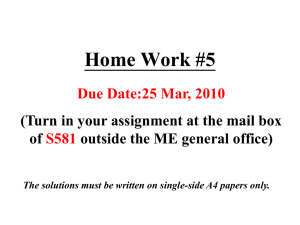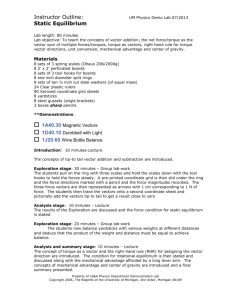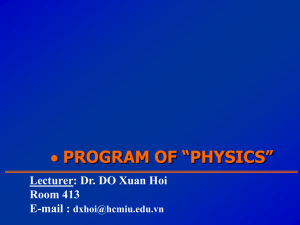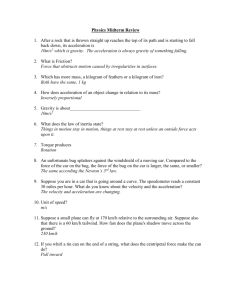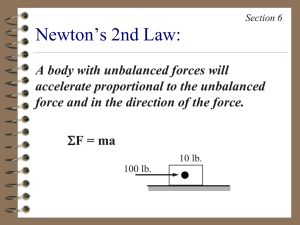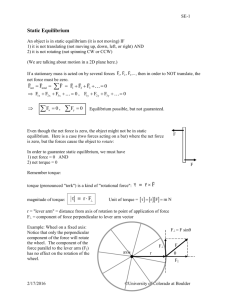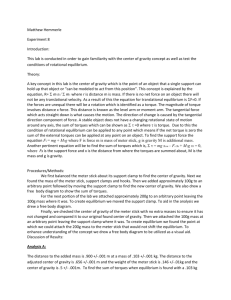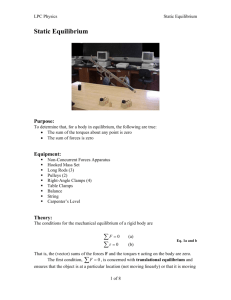Torque and Equilibrium Handout
advertisement
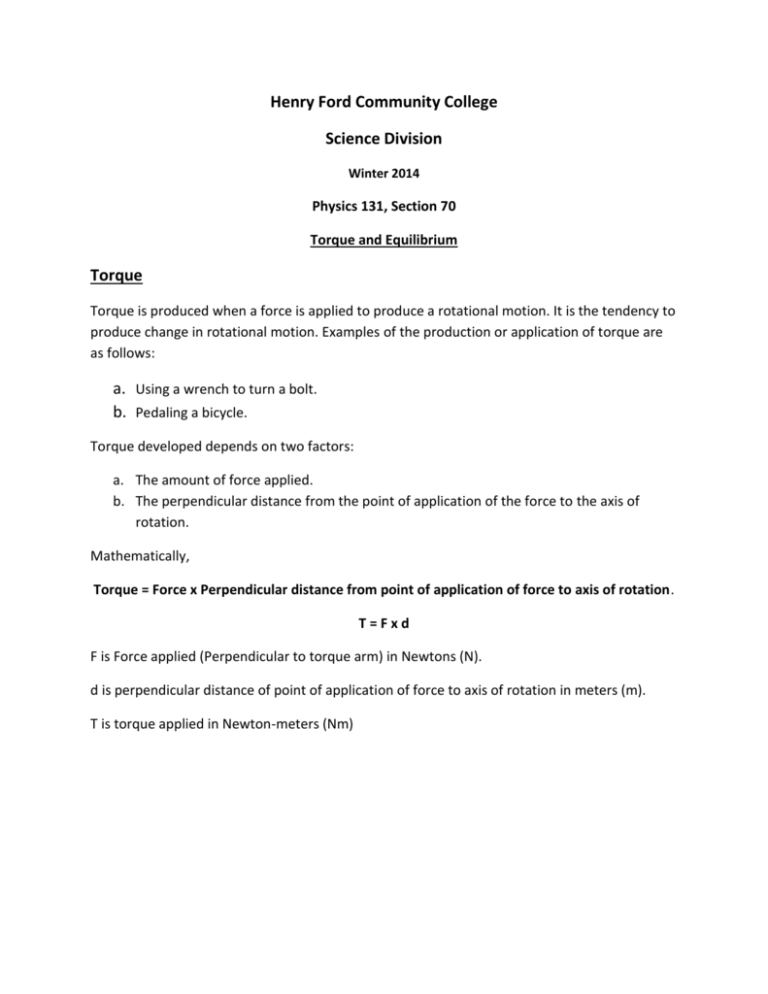
Henry Ford Community College Science Division Winter 2014 Physics 131, Section 70 Torque and Equilibrium Torque Torque is produced when a force is applied to produce a rotational motion. It is the tendency to produce change in rotational motion. Examples of the production or application of torque are as follows: a. Using a wrench to turn a bolt. b. Pedaling a bicycle. Torque developed depends on two factors: a. The amount of force applied. b. The perpendicular distance from the point of application of the force to the axis of rotation. Mathematically, Torque = Force x Perpendicular distance from point of application of force to axis of rotation. T=Fxd F is Force applied (Perpendicular to torque arm) in Newtons (N). d is perpendicular distance of point of application of force to axis of rotation in meters (m). T is torque applied in Newton-meters (Nm) Questions on Torque Question 1 (To be solved in class) Assuming that each force is applied perpendicular to the torque arm, calculate the torque applied in each case: a. F = 110 N; d = 0.420 m b. F = 50 N; d = 55 cm Question 2 (To be solved in class) If the torque on a shaft of radius 3.0 m is 35 Nm, what force is applied to the shaft? Question 3 (To be solved in class) A motorcycle head bolt is torqued to 25 Nm. What length of shaft is needed on a wrench to exert a maximum force of 80 N? Question 4 (To be solved in class) If the torque required to loosen a nut on the wheel of a pickup truck is 40 Nm, what minimum force must be applied to the end of a wrench 30 cm long to loosen the nut? Parallel Forces and Equilibrium Parallel Forces are forces with lines of action that do not meet. For parallel forces in equilibrium, the following conditions apply: First Condition of Equilibrium The sum of parallel forces on a body in equilibrium must be zero Second Condition of Equilibrium The sum of clockwise torques on a body in equilibrium must equal the sum of the counterclockwise torques about any point. Steps involved in solving parallel forces in equilibrium problems: 1. Sketch the problem. 2. Write an equation setting the sums of opposite forces equal to each other. 3. Choose a point of rotation (preferably a support). Eliminate a variable if possible (by making its torque arm zero). 4. Write the sum of all clockwise torques. 5. Write the sum of all counterclockwise torques. 6. Set the sum of clockwise torques to be equal to the sum of counterclockwise torques. 7. Solve the equation set up in step 6 above for the unknown quantity. 8. Substitute the value found in step 7 into the equation in step 2 to find the other unknown quantity. Questions on Parallel Forces in Equilibrium Question 1 (To be solved in class) A 10 kg window cleaner is standing 3 m from one end of an 8 m scaffold. If the scaffold is supported at each end by a stepladder, how much of the weight of the painter must each ladder support? Question 2 (To be solved in class) An auto transmission of mass 170 kg is located 1 m from one end of a 2.6 m bench. What weight must each end of the bench support? Question 3 (To be solved in class) A 2700 kg truck is 6 m from one end of a 30 m long bridge. A 1600 kg car is 20 m from the same end. How much weight must each end of the bridge support? Question 4 (To be solved in class) Two painters stand on a 12 m scaffold. One of mass 70 kg stands 3 m from one end. The other of mass 90 kg stands 5 m from the other end. They share a paint container of mass 20 kg located between the two and 2.5 m from the larger person. What weight must be supported by each of the ropes secured at the ends of the scaffold? Question 5 (Student Self Practice) An auto differential with a mass of 76 kg is 1 m from the end of a 2.2 m work-bench. What mass must each end of the workbench support? Question 6 (Student Self Practice) A bar 8 m long supports masses of 20 kg on the left end and 40 kg on the right end. At what distance from the 40 kg mass must the bar be supported for the bar to balance? Center of Gravity The Center of Gravity of any body is the point at which all of its weight is concentrated. Illustration of Center of Gravity of a Uniform Object. Illustration of the Center of Gravity of a Non-uniform Object. Questions on Parallel Forces in Equilibrium (Involving Center of Gravity) Question 1 (To be solved in class) Two construction workers carry a load weighing 750 N on a pole between them. The pole is 2 m long and the load is 0.5 m from the person on the left. a. What force must each person support? b. If the weight of the uniform pole is 130 N, what force does each person support? Question 2 (To be solved in class) A bridge across a country stream weighs 88,000 N. A large truck of mass 9000 kg stalls 4 m from one end of the 9 m bridge. What weight must each of the piers support? Question 3 (To be solved in class) A wooden pole is 4 m long and weighs 400 N. The center of gravity of the pole is 1.25 m from one end. What force is needed to lift each end? Question 4 (Student Self Practice) An auto engine of mass 295 kg is located 1 m from one end of a 4 m workbench. If the uniform bench has a mass of 45 kg, what weight must each end of the bench support?



